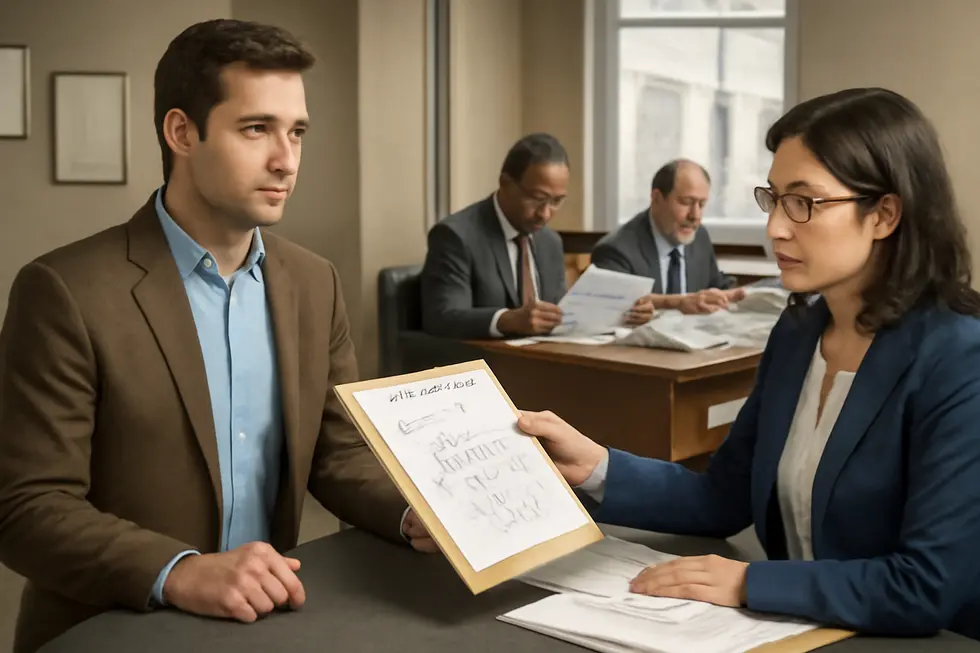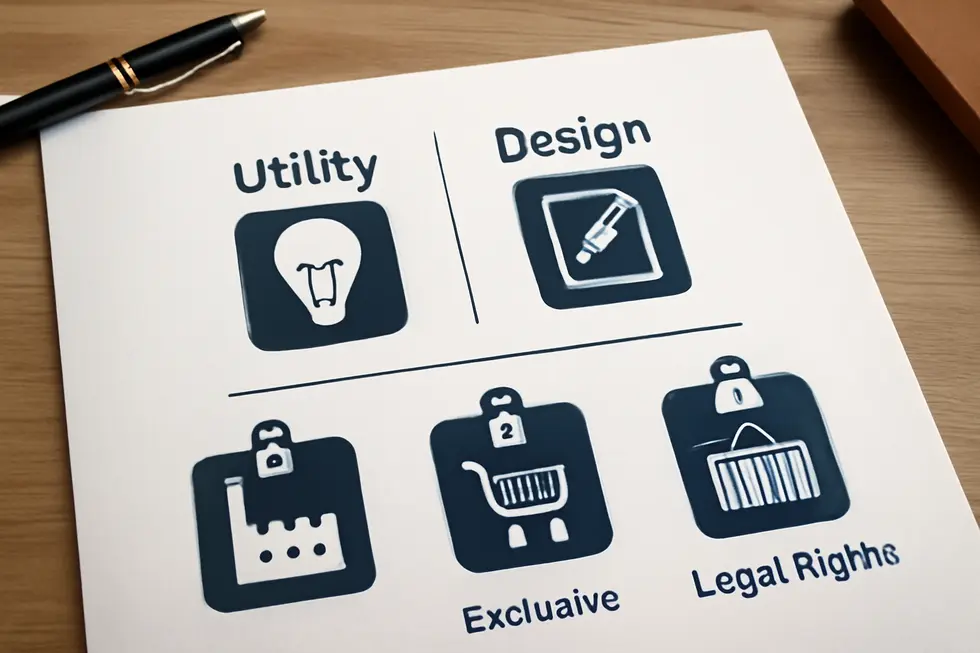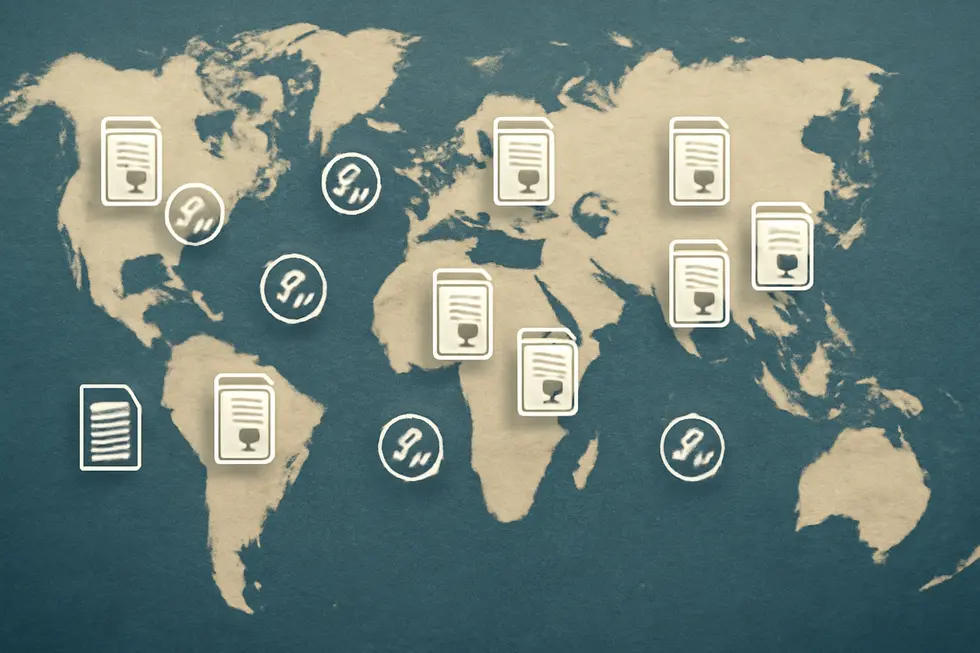Introduction
Understanding how patents work is crucial for business owners aiming to protect their innovations and secure competitive advantages. Patents grant exclusive rights to inventors, allowing businesses to control how their inventions are used, sold, or licensed. By grasping the patent application and examination process, recognizing the different types of patents available, and learning about international patent protection and enforcement, business owners can make informed decisions to maximize their intellectual property value. This knowledge not only helps in safeguarding inventions but also supports long-term business growth and innovation strategy.
Tables of Contents
Chapter 1: How Do Patents Work: Understanding the Patent Application and Examination Process
- Navigating Patent Filing and Initial Examination: The First Crucial Steps in Securing Patent Rights
- Navigating the Patent Examiner’s Substantive Review and Office Actions: Turning Applications into Patents
- Navigating Patent Issuance and Maintaining Exclusive Rights After Grant
Chapter 2: How Do Patents Work: Types of Patents and Legal Rights Granted
- Exploring the Distinct Roles of Utility, Design, and Plant Patents in Protecting Innovations
- Understanding the Exclusive Rights Patents Grant and How Inventors Enforce Them
- The Far-Reaching Economic and Technological Influence of Patent Rights
Chapter 3: How Do Patents Work: International Patent Protection and Enforcement
- Navigating the Territorial Boundaries: Understanding International Patent Rights and Enforcement
- Expanding Global Reach: How the Patent Cooperation Treaty Simplifies International Patent Filings and Protection
- Navigating National and Regional Enforcement: The Backbone of International Patent Protection
Chapter 1: How Do Patents Work: Understanding the Patent Application and Examination Process

1. Navigating Patent Filing and Initial Examination: The First Crucial Steps in Securing Patent Rights
The journey toward securing a patent begins with the meticulous drafting and filing of a patent application. This document forms the foundation for protection and must thoroughly describe the invention, covering its title, background, detailed description, and carefully crafted claims that define the legal scope of the invention. Including clear drawings often helps to illustrate the innovation precisely, ensuring clarity and meeting the stringent legal criteria needed for patentability.
Once the application is filed—commonly through electronic systems within patent offices—the process advances to an initial formal examination. This early review confirms procedural compliance, such as completeness of required documents, proper formatting, and payment of filing fees. In some jurisdictions, inventors must explicitly request a substantive examination to trigger the in-depth evaluation stage.
Following this, the application is assigned to a patent examiner with expertise in the relevant technological area. The examiner conducts a rigorous search of existing patents and scientific literature to ascertain if the invention is new, useful, and non-obvious compared to prior art. This review is fundamental because a patent’s validity hinges on these criteria.
Should concerns arise, the examiner issues official communications known as Office Actions. These may object to certain claims or require clarification, prompting the applicant to respond thoughtfully within strict deadlines. Typically, applicants work alongside patent professionals to amend claims or provide legal arguments that address the examiner’s issues effectively.
This dialog between applicant and examiner may repeat as needed, with each response steering the evaluation closer to resolution. Ultimately, if the examiner is convinced that the invention satisfies all patentability requirements, the patent is granted. Conversely, failure to resolve objections or meet standards may result in refusal or abandonment of the application.
Navigating these initial stages requires careful preparation and strategic interaction with the patent office to enhance the likelihood of success. Understanding this complex process illuminates how patents begin protecting inventors’ rights from the earliest interactions with the patent system.
For an authoritative overview of the U.S. patent application process, the detailed guide from Global Patent Filing offers comprehensive insights. Additionally, learn more about formal and substantive examination phases through resources that explain the critical procedural steps.
For further reading, visit Global Patent Filing’s complete guide on the U.S. patent application process. You can also explore trademark2go.com’s detailed explanations of intellectual property categories, which provide useful context on how patents fit within broader intellectual property protection.
2. Navigating the Patent Examiner’s Substantive Review and Office Actions: Turning Applications into Patents
Once a patent application passes the initial formalities check, it advances to the crucial stage of substantive examination conducted by a patent examiner. Here, the examiner rigorously assesses whether the invention fulfills key legal standards: novelty, non-obviousness, and industrial applicability. This evaluation hinges on an extensive prior art search, where the examiner reviews existing patents, scientific publications, and public disclosures to ensure the invention is truly new and inventive.
During this phase, the examiner scrutinizes the claims—the precise wording that defines the scope of the invention, as well as the detailed description and any accompanying drawings. If the examiner identifies issues, such as overlapping prior art or insufficient clarity in the claims, they issue an Office Action. This official communication outlines objections, rejections, or requests for additional information. The applicant then has the opportunity to respond, often by amending claims to clarify boundaries or submitting arguments to distinguish the invention from existing technology.
This exchange between examiner and applicant can involve multiple rounds. Each Office Action and response sharpens the application to better meet legal criteria. If disagreements persist after these interactions, a Final Office Action may be issued. Applicants frustrated by a final rejection may pursue further options like filing a Request for Continued Examination (RCE) or appealing to higher authorities, maintaining the possibility of eventual patent grant.
Successfully addressing all examiner concerns results in a Notice of Allowance—an official green light signaling the impending grant of the patent, contingent on payment of issue fees. This meticulous substantive review process ensures that patents are awarded only to inventions meeting rigorous standards, protecting genuine innovation while maintaining a fair and transparent system.
Due to the complexity of responding effectively to Office Actions and navigating substantive review, many applicants engage patent attorneys to guide them through the process.
For a more detailed overview of each stage, including advice on preparing applications and responses, PatentPC’s guide on the Step-by-Step Process for Patent Examination offers valuable insights.
3. Navigating Patent Issuance and Maintaining Exclusive Rights After Grant
The journey from application to patent grant culminates in securing exclusive rights that protect an invention for a limited time, but this protection requires ongoing commitment. After a thorough examination confirms the invention’s novelty, usefulness, and non-obviousness, the patent office issues a Notice of Allowance. At this stage, the applicant must pay an issue fee to officially receive the patent certificate, which marks the start of the patent term—typically 20 years from the original filing date. This formal grant legally empowers the inventor to exclude others from making, using, or selling the invention without permission.
However, obtaining a patent is not the final step to preserving these exclusive rights. Post-grant, patentees are obligated to pay periodic maintenance fees at set intervals to keep their patents enforceable. Failure to meet these payments results in patent expiration before the full term elapses, allowing the invention to enter the public domain. This system balances rewarding inventors while encouraging timely commercial exploitation and innovation dissemination.
Beyond fee payments, patent holders often need to actively monitor the market and enforce their rights against potential infringers. Patentees can license their patents or challenge unauthorized use through legal proceedings, which uphold the value and exclusivity granted by the patent. It is important to note that while a patent gives the right to exclude others, it does not inherently grant the patent owner the right to use the invention if other laws apply.
For inventors seeking broader protection, international strategies such as filings under the Patent Cooperation Treaty (PCT) enable simultaneous pursuit of patents in multiple countries via a streamlined process. This global approach requires careful management of deadlines and fees in each jurisdiction to maintain rights worldwide.
Navigating these stages—from paying issue fees to maintaining patents over years—requires vigilance and often professional assistance to ensure that valuable inventions remain protected throughout their lifespan. This ongoing stewardship embodies the core purpose of the patent system: promoting progress by granting time-limited monopolies in exchange for public disclosure.
For further detailed guidance on the patent examination and granting stages, a step-by-step resource is available here: Patent Examination Process.
Chapter 2: How Do Patents Work: Types of Patents and Legal Rights Granted

1. Exploring the Distinct Roles of Utility, Design, and Plant Patents in Protecting Innovations
Patents serve as legal tools that grant inventors exclusive rights to their inventions, preventing others from making, using, selling, or importing these creations without permission for a limited time. This exclusivity encourages innovation by offering inventors a temporary monopoly in exchange for publicly sharing the details of their inventions. Among the various types of patents, three principal categories exist: utility patents, design patents, and plant patents. Each type is tailored to protect a specific aspect of innovation, reflecting the diversity of inventions and creative works.
Utility patents are the most common and cover functional inventions that demonstrate novelty, usefulness, and non-obviousness. These patents protect how something works, whether it is a machine, a method, a composition of matter, or an improvement on existing technology. For instance, a new manufacturing process, a chemical compound, or a software algorithm could qualify for utility patent protection, typically lasting 20 years from the filing date. The application process requires detailed technical descriptions and claims to clearly establish the invention’s boundaries, ensuring that others cannot unlawfully exploit its functional features.
Design patents, in contrast, focus on the ornamental or aesthetic aspects of an article of manufacture. They do not protect how an invention works but rather how it looks. This includes the shape, surface ornamentation, and overall visual appearance of products like furniture, clothing, or consumer electronics. Design patents last 15 years from the grant date and emphasize detailed drawings or photographs to capture the unique appearance. Because of their visual focus, design patents can be particularly effective in combating counterfeit goods that copy a product’s distinct look.
Plant patents occupy a unique niche by protecting new and distinct varieties of asexually reproduced plants. The protection covers the entire plant, barring others from reproducing, selling, or using it without authorization. Plant patents last 20 years from the filing date and require precise botanical descriptions and evidence of asexual reproduction methods such as grafting or cutting. Not all plants qualify; for example, tuber-propagated plants like potatoes are excluded.
It’s possible for inventors to seek multiple patent types to cover different facets of one invention, such as securing a utility patent for its function and a design patent for its ornamental features. Although patents grant the right to exclude others, they do not automatically confer the right to use the invention if other laws apply. Specialized fields like biotechnology rely heavily on utility patents to protect products and processes related to pharmaceuticals and genetic innovations.
For those interested in a broader understanding of intellectual property, exploring related protections such as trademarks can provide insightful context on brand and design rights within the business landscape. Learn more about trademark protection for business names and logos.
For further detailed information about the three types of patents and their specific requirements, the PatentPC guide on the three types of patents offers an excellent resource.
2. Understanding the Exclusive Rights Patents Grant and How Inventors Enforce Them
Patents provide inventors with the powerful legal ability to exclude others from making, using, selling, offering for sale, or importing their invention within the jurisdiction where the patent is granted. However, this exclusivity does not automatically authorize the patent owner to practice the invention themselves, particularly if other laws or existing rights restrict such usage. Instead, a patent works primarily as a defensive tool, allowing its holder to prevent unauthorized exploitation by competitors or imitators.
There are three primary categories of patents, each conferring distinct protections aligned with different aspects of innovation. Utility patents, the most common, cover new and useful inventions such as machines, processes, manufactured articles, or chemical compositions, and improvements thereof. A typical utility patent lasts 20 years from the original filing date, providing a lengthy period of protection for the invention’s functional characteristics. Design patents, in contrast, protect the ornamental appearance of an article rather than its utility. These patents generally last between 14 to 15 years and do not require maintenance fees, reflecting their focus on aesthetic innovation rather than technical function. Lastly, plant patents cover newly invented or discovered plants that are asexually reproduced, excluding tubers, protecting unique botanical developments.
Once a patent is officially granted by a patent office such as the United States Patent and Trademark Office (USPTO), the rights become enforceable. However, enforcement is the sole responsibility of the patent owner; government agencies do not initiate or carry out infringement actions. Instead, the patent holder must monitor the market and pursue legal remedies in court against infringers who utilize the protected invention without permission. Such enforcement helps maintain the value of the patent by deterring unauthorized uses and fostering an incentive for innovation.
At the core, the patent examination process ensures that only inventions fulfilling rigorous criteria of novelty, usefulness, and non-obviousness receive these exclusive rights. A published patent application serves as a public disclosure of the invention but without enforceable rights until the patent is formally issued.
This system encourages technological progress by granting inventors a temporary monopoly in return for sharing knowledge publicly. Inventors gain the ability to control how their invention is commercially exploited or licensed, ultimately supporting investment recovery and further research.
For more detailed guidance on specific patent types and their legal implications, resources such as UpCounsel’s guide on Patent Type Grants provide valuable insights. Additionally, understanding the differences between patent rights and other intellectual property protections, such as trademarks, can be aided by visiting comprehensive resources on trademark protection for business names and logos.
3. The Far-Reaching Economic and Technological Influence of Patent Rights
Patents act as powerful catalysts for both economic growth and technological advancement by granting inventors a temporary monopoly on their creations. This exclusive right provides a financial incentive crucial for recovering the often substantial research and development costs associated with innovation. Companies holding patents frequently experience notable revenue growth, sometimes increasing by up to 50%, especially in technology-driven sectors like healthcare and electronics. Beyond direct profits, patents enhance a firm’s market valuation by signaling innovative potential to investors and venture capitalists, thereby unlocking further funding opportunities.
Universities and research institutions also leverage patents to contribute to local economies, supporting job creation and boosting GDP growth. However, the economic benefits of patents depend greatly on sound policy frameworks. Changes affecting patent ownership or enforcement can risk diminishing innovative outputs by reducing incentives or creating uncertainty for creators.
Technologically, the patent system encourages the dissemination of knowledge through mandatory public disclosure of inventions. This transparency enables other innovators to learn from existing technologies, either building upon them after patents expire or designing alternative solutions that avoid infringement. Such knowledge sharing fosters a cumulative innovation environment, stimulating diverse advances across industries.
Additionally, patents facilitate technology transfer via licensing agreements, allowing wider utilization of inventions and creating business partnerships across borders. Global efforts toward harmonizing patent laws aim to simplify cross-national filings, lower costs, and balance patent holders’ rights with broader societal needs such as public health considerations.
Together, patents form a critical bridge linking intellectual property rights with sustained economic development and technological progress worldwide. They provide inventors with the motivation and protection needed to invest in breakthrough ideas while ultimately contributing to the collective expansion of knowledge and industrial capability.
For a better understanding of how these legal protections fit in the larger framework of intellectual property, readers may explore related insights on categories of intellectual property and their role in business innovation.
For further detail on the economic implications of patents, the World Intellectual Property Organization (WIPO) offers in-depth resources exploring the intersection of patent rights and innovation economics: https://www.wipo.int/edocs/pubdocs/en/wipopub944_2020.pdf
Chapter 3: How Do Patents Work: International Patent Protection and Enforcement

1. Navigating the Territorial Boundaries: Understanding International Patent Rights and Enforcement
Patents inherently carry a territorial limitation, meaning that the exclusive rights they provide are confined to the borders of the country or region where they are granted. This fundamental principle requires inventors and companies seeking international protection to file separate patent applications in each jurisdiction of interest. A patent granted in the United States, for example, does not protect the invention in Europe, China, or any other foreign market. Consequently, the global patent landscape is shaped by a mosaic of national or regional rights rather than a single worldwide patent.
To ease the complexity of multiple national filings, international frameworks like the Patent Cooperation Treaty (PCT) have been established. The PCT system allows applicants to submit one international application that can later enter the “national phase” in over 150 member countries. However, it is important to emphasize that the PCT does not grant an international patent. Instead, it simplifies the filing process, postpones substantial costs for up to 30 or 31 months, and delays the moment when applicants must commit to national filings. This system therefore provides strategic time and cost benefits but ultimately requires pursuing patent grants individually under each country’s laws.
Complementing the PCT, the Paris Convention enables applicants to claim priority from an initial filing when applying in other member countries within 12 months. This provision harmonizes timing yet stops short of creating unified patent rights. On the regional level, patent offices such as the European Patent Office (EPO) offer a more consolidated route: a single application can result in patent protection across multiple European states. Even so, the patent’s enforceability remains dependent on validation in each country, respecting continued territorial boundaries.
Enforcement of patent rights similarly adheres strictly to territorial borders. Patent holders must initiate legal actions individually in each jurisdiction where infringement arises, as national courts interpret and apply patent laws independently. International agreements, such as the TRIPS Agreement, set minimum standards for enforcement and encourage cooperation among countries but do not unify enforcement laws or procedures.
In summary, international patent protection and enforcement require careful strategic planning and navigation through diverse legal systems. Inventors benefit from treaty-supported mechanisms that streamline procedures but should expect to manage claims and defenses on a country-by-country basis. Consulting with patent professionals experienced in international patent law is crucial to optimize protection and enforcement across borders.
For further understanding of international patent strategies and procedures, the detailed overview by the World Intellectual Property Organization on the Patent Cooperation Treaty (PCT) provides valuable insights.
2. Expanding Global Reach: How the Patent Cooperation Treaty Simplifies International Patent Filings and Protection
Patents inherently protect inventions within the borders of individual countries or regions, with rights granted and enforced according to each jurisdiction’s laws. Navigating this territorial landscape can be complex and costly for inventors seeking global protection. The Patent Cooperation Treaty (PCT) was established to address these challenges by streamlining the international patent application process and enabling a coordinated approach for securing patent rights in multiple countries.
Administered by the World Intellectual Property Organization (WIPO), the PCT allows inventors to file a single international application that serves as a placeholder for patent protection in various member states. This unified filing system reduces immediate administrative burdens and upfront costs by deferring the need to file individual national applications separately. Upon filing, an International Searching Authority (ISA) conducts a comprehensive search of existing patents and public disclosures, providing an initial assessment of the invention’s novelty and inventive step. This early insight helps applicants understand the potential patentability of their invention before significant further expenses.
Approximately 18 months from the priority date, WIPO publishes the international application, making it publicly accessible worldwide and alerting third parties of the pending patent claim. Applicants may also opt for an additional preliminary examination to clarify patentability questions and refine their application before entering the subsequent national phase. Around 30 months after the original filing, inventors must decide in which specific countries or regions to proceed with patent prosecution, entering the national or regional phases governed by local patent offices. It is in these phases that actual patents are granted, and territorial rights begin to take effect.
Although the PCT simplifies initial filings and harmonizes formal procedural aspects, such as document submission and inventor identification, it does not itself grant patents nor unify enforcement. Patent rights remain territorial and enforceable only under each country’s legal system. Consequently, inventors must still navigate differing substantive patent laws and litigation processes once national patents are obtained.
This system balances broad international coverage with manageable procedural complexity. It empowers inventors and businesses to strategize patent protection globally while respecting national sovereignty over intellectual property rights. For those seeking to understand more about safeguarding innovations and related intellectual property rights, learning about company intellectual property protection can provide valuable insights.
More detailed guidance on the PCT process and its role in international patent protection is available through WIPO’s official resources.[1]
[1] https://www.wipo.int/pct/en/
3. Navigating National and Regional Enforcement: The Backbone of International Patent Protection
Patents do not grant a universal right enforceable across all countries. Instead, patent protection is territorial, controlled by national or regional laws. When inventors seek to protect their innovations internationally, they must navigate a complex patchwork of legal mechanisms available within each jurisdiction. Patents are granted by national patent offices, such as the USPTO in the United States, or by regional entities like the European Patent Office. These offices enforce their respective laws and grant exclusive rights applicable only within their borders.
Enforcement of these rights involves a variety of legal tools. Civil litigation is the most common route where patent holders initiate lawsuits in national courts to stop infringement. Outcomes may include injunctions preventing further unauthorized use, monetary damages, or orders to surrender counterfeit goods. In certain countries, enforcement extends beyond civil remedies into criminal penalties, particularly for large-scale patent counterfeiting. Customs authorities play a critical role by intercepting infringing products at borders, using both national regulations and international frameworks such as those established by the World Customs Organization.
Beyond litigation, alternative dispute resolution (ADR) methods—like mediation and arbitration—offer efficient paths to settle cross-border patent disputes. Organizations such as WIPO administer arbitration services that help resolve conflicts involving licensing agreements or technology transfer without costly court proceedings.
International patent protection processes are supported by treaties that streamline filings but do not replace national enforcement. The Patent Cooperation Treaty (PCT) notably facilitates filing a single international application that can later enter multiple national or regional phases, delaying and consolidating initial administrative burdens. However, final enforcement always depends on the patent laws of each jurisdiction.
This territorial nature means inventors must enforce rights independently in each country violating their patents, coordinating strategies accordingly. Additionally, transferring patent ownership globally requires careful compliance with each jurisdiction’s formalities to maintain enforceable title.
Together, these national and regional enforcement mechanisms form the backbone of international patent protection. They balance sovereign control with practical frameworks, enabling inventors to safeguard their innovations across borders while navigating a legally diverse landscape.
For those interested in practical strategies and cost considerations of international patents, see guidance on international patent costs and filing strategies.
Final thoughts
Patents serve as powerful tools for business owners to protect their inventions and maintain a competitive edge. By understanding the patent application and examination process, recognizing the different types of patents available, and leveraging international patent protection and enforcement mechanisms, businesses can strategically safeguard their innovations worldwide. With the right patent knowledge, business owners not only secure exclusive rights that foster innovation but also ensure their intellectual property investments yield long-term value and market success.
Your IP is the foundation of your success – let’s protect it together before it’s too late. We can’t wait to help you turn your ideas into legally secured assets.
About us
undefined


